OCZ Vertex 3 (240GB) Review
by Anand Lal Shimpi on May 6, 2011 1:50 AM ESTAnandTech Storage Bench 2011
Last year we introduced our AnandTech Storage Bench, a suite of benchmarks that took traces of real OS/application usage and played them back in a repeatable manner. I assembled the traces myself out of frustration with the majority of what we have today in terms of SSD benchmarks.
Although the AnandTech Storage Bench tests did a good job of characterizing SSD performance, they weren't stressful enough. All of the tests performed less than 10GB of reads/writes and typically involved only 4GB of writes specifically. That's not even enough exceed the spare area on most SSDs. Most canned SSD benchmarks don't even come close to writing a single gigabyte of data, but that doesn't mean that simply writing 4GB is acceptable.
Originally I kept the benchmarks short enough that they wouldn't be a burden to run (~30 minutes) but long enough that they were representative of what a power user might do with their system.
Not too long ago I tweeted that I had created what I referred to as the Mother of All SSD Benchmarks (MOASB). Rather than only writing 4GB of data to the drive, this benchmark writes 106.32GB. It's the load you'd put on a drive after nearly two weeks of constant usage. And it takes a *long* time to run.
Here's a high level overview:
1) The MOASB, officially called AnandTech Storage Bench 2011 - Heavy Workload, mainly focuses on the times when your I/O activity is the highest. There is a lot of downloading and application installing that happens during the course of this test. My thinking was that it's during application installs, file copies, downloading and multitasking with all of this that you can really notice performance differences between drives.
2) I tried to cover as many bases as possible with the software I incorporated into this test. There's a lot of photo editing in Photoshop, HTML editing in Dreamweaver, web browsing, game playing/level loading (Starcraft II & WoW are both a part of the test) as well as general use stuff (application installing, virus scanning). I included a large amount of email downloading, document creation and editing as well. To top it all off I even use Visual Studio 2008 to build Chromium during the test.
Digging a little deeper, the test has 2,168,893 read operations and 1,783,447 write operations. The IO breakdown is as follows:
| AnandTech Storage Bench 2011 - Heavy Workload IO Breakdown | ||||
| IO Size | % of Total | |||
| 4KB | 28% | |||
| 16KB | 10% | |||
| 32KB | 10% | |||
| 64KB | 4% | |||
Only 42% of all operations are sequential, the rest range from pseudo to fully random (with most falling in the pseudo-random category). Average queue depth is 4.625 IOs, with 59% of operations taking place in an IO queue of 1.
Many of you have asked for a better way to really characterize performance. Simply looking at IOPS doesn't really say much. As a result I'm going to be presenting Storage Bench 2011 data in a slightly different way. We'll have performance represented as Average MB/s, with higher numbers being better. At the same time I'll be reporting how long the SSD was busy while running this test. These disk busy graphs will show you exactly how much time was shaved off by using a faster drive vs. a slower one during the course of this test. Finally, I will also break out performance into reads, writes and combined. The reason I do this is to help balance out the fact that this test is unusually write intensive, which can often hide the benefits of a drive with good read performance.
There's also a new light workload for 2011. This is a far more reasonable, typical every day use case benchmark. Lots of web browsing, photo editing (but with a greater focus on photo consumption), video playback as well as some application installs and gaming. This test isn't nearly as write intensive as the MOASB but it's still multiple times more write intensive than what we were running last year.
As always I don't believe that these two benchmarks alone are enough to characterize the performance of a drive, but hopefully along with the rest of our tests they will help provide a better idea.
The testbed for Storage Bench 2011 has changed as well. We're now using a Sandy Bridge platform with full 6Gbps support for these tests. All of the older tests are still run on our X58 platform.
AnandTech Storage Bench 2011 - Heavy Workload
We'll start out by looking at average data rate throughout our new heavy workload test:

The breakdown of reads vs. writes tells us more of what's going on:
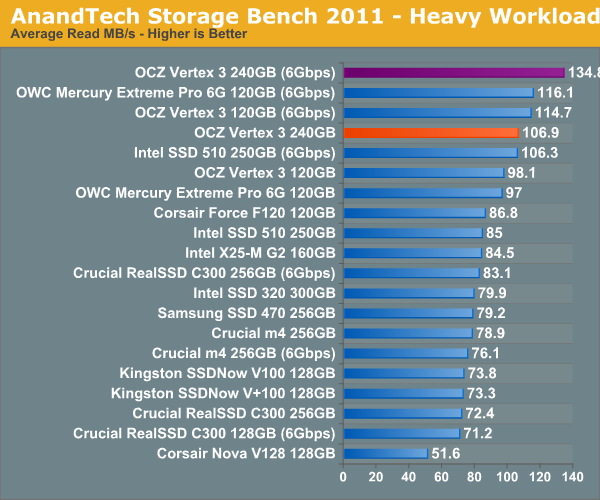
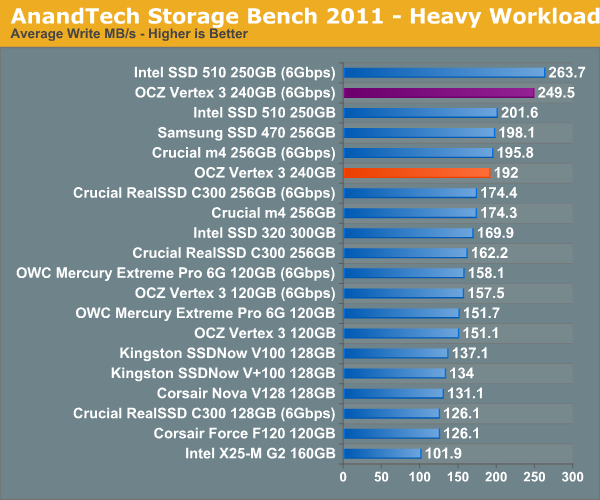
The next three charts just represent the same data, but in a different manner. Instead of looking at average data rate, we're looking at how long the disk was busy for during this entire test. Note that disk busy time excludes any and all idles, this is just how long the SSD was busy doing something:
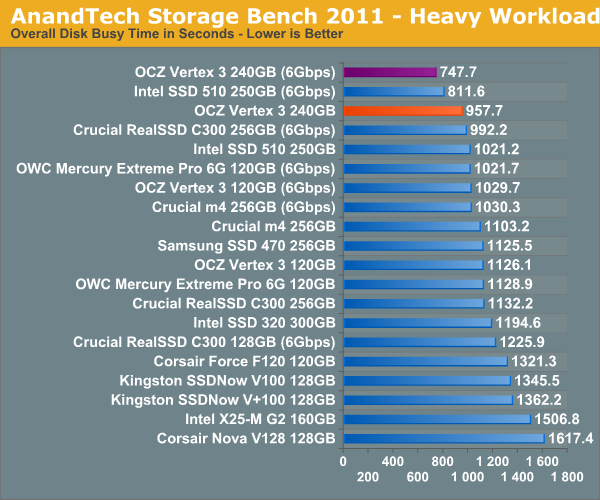
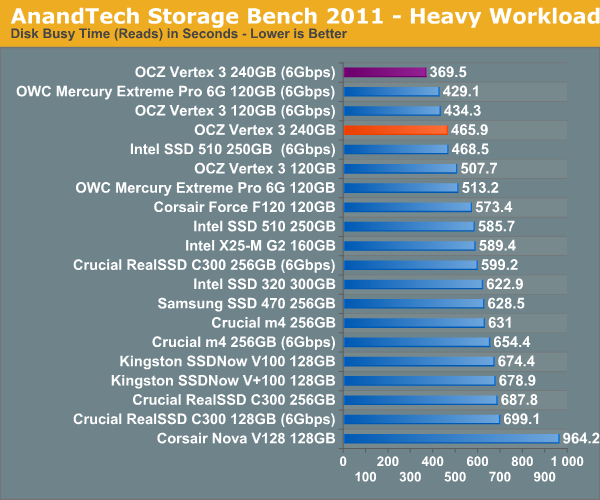
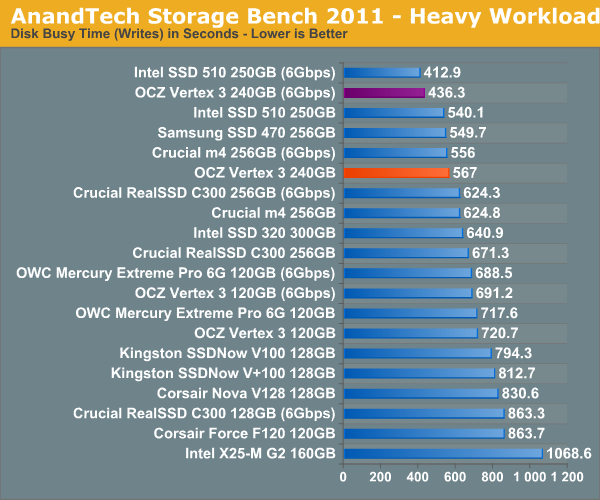










90 Comments
View All Comments
dagamer34 - Friday, May 6, 2011 - link
Yeah, I kinda addressed that with the fact that "should you pay $100 to boot Windows in 9 seconds instead of 14". I'm arguing the practical purpose of it, not the theoretical one.People don't buy SSDs for faster boot times because that's something you do only once a day. They buy them to avoid the silly 15 sec Photoshop load time and increase the general responsiveness of their system. Once you go from 6.8ms latency to 0.1ms latency, I don't see how you improve that further.
Omid.M - Friday, May 6, 2011 - link
I've noticed every time you cover SSDs that you have a recommendation for OS X that's generally different from your conclusion in the article.Is that the case here as well?
How would you rank the top 3 SSDs for Macs, if each is from a different vendor? From a reliability standpoint, as I don't think the difference in speed is noticeable to the end user unless performing specific tasks:
Intel 510 (or 320)
Vertex 3
Crucial C300
What do you think, Anand?
@moids
purrcatian - Friday, May 6, 2011 - link
Macs don't support TRIM. There aren't too many high performance SSDs with which you can get away with using them without TRIM and expect long term speed. SandForce controllers have always been good at working without TRIM, so the Vertex 3 would likely be your best bet.The Marvel controllers in the Crucial C300 and Intel 510 are know for not working too well without TRIM, so they wouldn't be a good choice for a Mac.
Anand Lal Shimpi - Friday, May 6, 2011 - link
If you've got a Mac with a 6Gbps interface, then the Vertex 3 240GB is a solid recommendation. Note that some users have had issues with the 2011 MBPs and Vertex 3s but personally I've lucked out. I suspect there may be some odd issues with Apple's ribbon cable for the 6Gbps bay.If you're running a 3Gbps Mac then I'd say SSD 510 or 320. Still waiting to see how the smaller capacity drives perform though.
Take care,
Anand
Omid.M - Friday, May 6, 2011 - link
Anand,And I bet Apple has been silent about the ribbon cable theory?
I would hope a company with so many engineering resources (and so vertically integrated) could quickly look into something like that and rule it out.
@moids
darwinosx - Friday, May 6, 2011 - link
I know why wouldn't Apple drop everything and use all their resources to investigate every theory about their hardware...darwinosx - Friday, May 6, 2011 - link
Many, many Mac users are having issues with the Intel 510 but have seen no issues with the 320.kasakka - Friday, May 6, 2011 - link
OSX does support TRIM now, but it's only enabled for Apple branded drives. There's a hack that lets you enable it for all drives and at least on my X25-M it shows as enabled but can't say anything about performance - even without it the drive has been very fast for the year I've had it.I guess that OSX Lion will officially support TRIM for all drives.
Omid.M - Friday, May 6, 2011 - link
Thanks for the reply.I understand TRIM is not supported natively for non-Apple SSDs, but I also have read about the kext hack that enables TRIM for 3rd party drives. Of course, my question implies that I would enable this hack to try it out.
From what I've read on MacRumors forums (and I believe AT forums), people are having better luck with Intel 320 than the Vertex 3. The speed difference can't be that noticeable in every day use (save for niche situations?), so I'd take reliability over a marginal increase in speed, assuming TRIM would be enabled via the hack.
I think I would take the Intel 320 300 GB (280 GB usable) over the Vertex 3 240 GB.
I'd love to see a comparison of error rates (RMA rates, I guess) between the manufacturers for those specific drive capacities.
Maybe AFTER OCZ sends Anand the last batch of requested SSDs for testing? :)
@moids
darwinosx - Friday, May 6, 2011 - link
But they will in a month or so when Tiger comes out. Or you can download TRIM functionality right now.